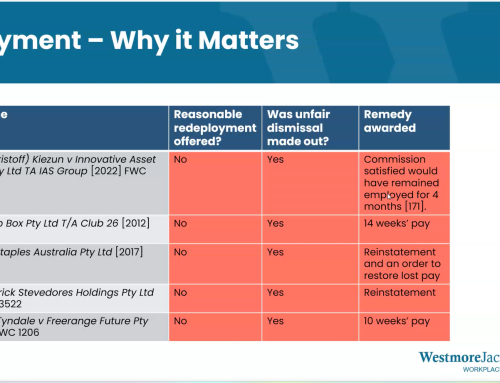
After months of agonising, you make a tough decision. The business is going to make (or propose) redundancies.
Now you need to think about implementation. Which position(s) should be made redundant? How am I going to break the news? Should redeployment be offered? Can redundant employees bring an unfair dismissal claim?
Below we share our top tips.
1. Redeployment – assume nothing:
Many employers make assumptions about an employee’s willingness or ability to undertake a vacancy within the business. An employer may assume the job is too junior, pays too little, or the employee does not have the requisite qualifications and experience etc. So a vacancy is neither offered nor discussed with the employee.
Jenny Craig Weight Loss Centres Pty Ltd v Margolina is a valuable lesson about making assumptions like this. Here the employer failed to offer a Regional Manager earning about $102,000 per year redeployment opportunities paying around $38,000 per year. The employer considered it would have been an insult to offer the lower paying roles to the redundant employee.
The employee disagreed and claimed unfair dismissal. She argued that lower paying jobs should have been offered to her. She gave evidence that the reduced working hours of these jobs would have suited her because:
“At that time in my life I would be happy to even do a part-time job with the company because my daughter did not know I’m her mother”.
The Commission found the employer should have offered a lower paying job.
2. Understand the ‘consultation’ obligations
Employers need to understand their consultation obligations.
For instance, the model Modern Award consultation term regarding major workplace change does not require employers to provide an employee with an opportunity to change a definite decision to make redundancies. This is because there is (ironically) no obligation to consult with employees about the changes. Instead, there is only an obligation to discuss the changes (this discussion must occur before the change is implemented).
However, if an Enterprise Agreement includes an obligation to consult about changes, then an opportunity to persuade the employer to revoke or modify its proposed decision should be provided.
Additionally, the Fair Work Act includes further consultation obligations which sometimes apply. Employers proposing to make 15 or more employees redundant will need to consult with union(s) if one or more employees are union members and the union(s) is entitled to represent employee(s)’ industrial interests (i.e., the union has coverage).
The Fair Work Act includes further obligations to notify Centrelink where there are 15 or more redundancies.
3. Check your selection criteria doesn’t indirectly discriminate
Employers should check the selection criteria for deciding who would be made redundant does not indirectly discriminate.
The classic example here is making all part-time or casual employees redundant in the first round of redundancies. Sometimes the demographics of a workforce can be such that a higher proportion of part-time and casual employees are female (whereas a higher percentage of males work full-time)
4. Support, support, support
Not all employees will react the same way to the news of redundancy. Some may be thrilled at the prospect of tax free redundancy pay. Others may be worried about supporting their families and meeting financial commitments. Some employees may just want to be left alone.
Be as flexible and supportive as possible. This may include allowing employees time off work to attend interviews. It may also include supporting employees via EAP and outplacement services.
Anecdotally, employees who feel supported during the redundancy process are more likely to advocate your brand. They may also be less inclined to litigate.
5. Get help early
If you feel you’re out of your depth, it’s a good sign you probably are.
There are so many potential pitfalls with redundancy. And there is a significant body of case law about them.
It’s best to get good advice early. It could save your business much heartache and expense later.
Adam Colquhoun, Principal






Leave A Comment